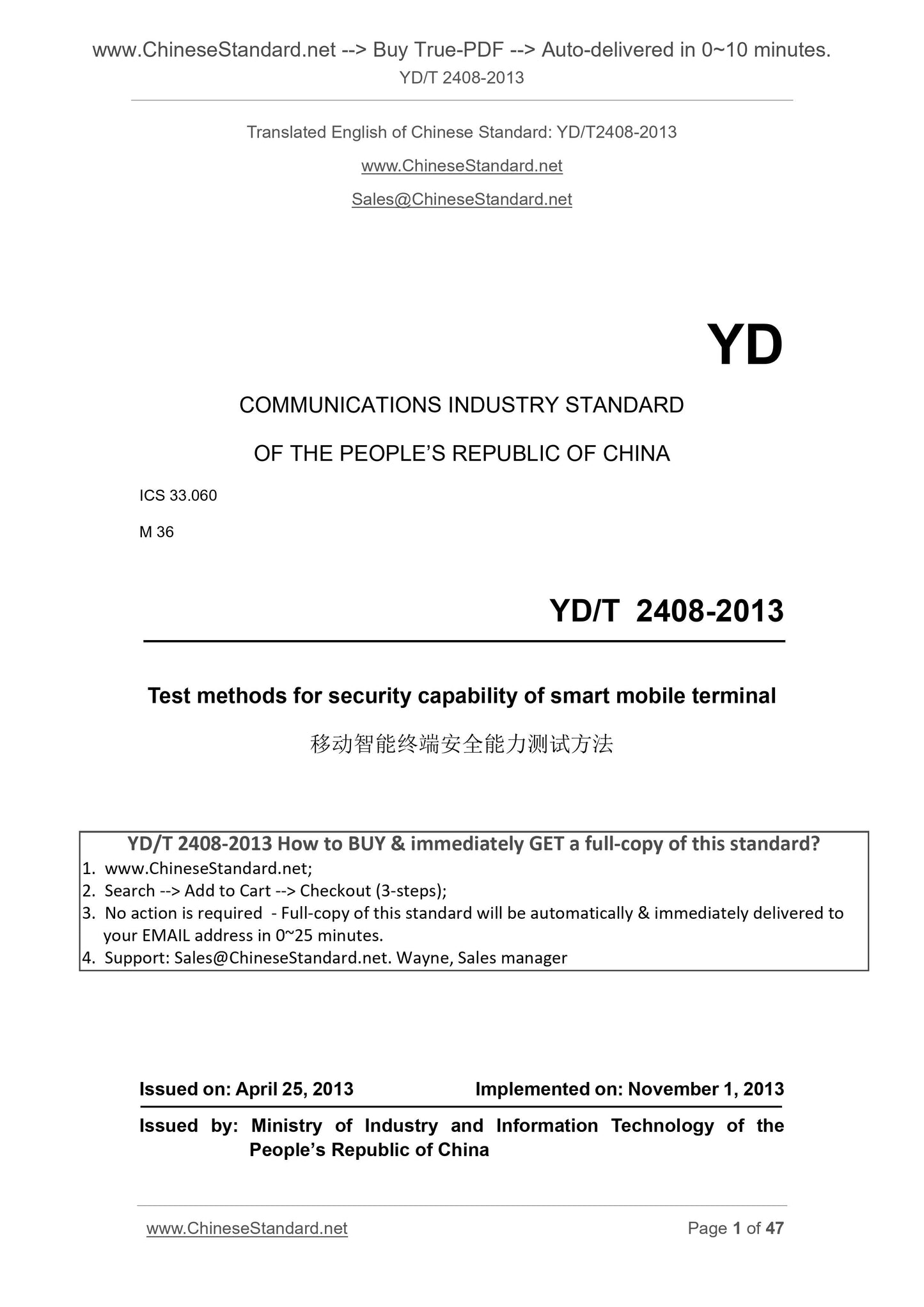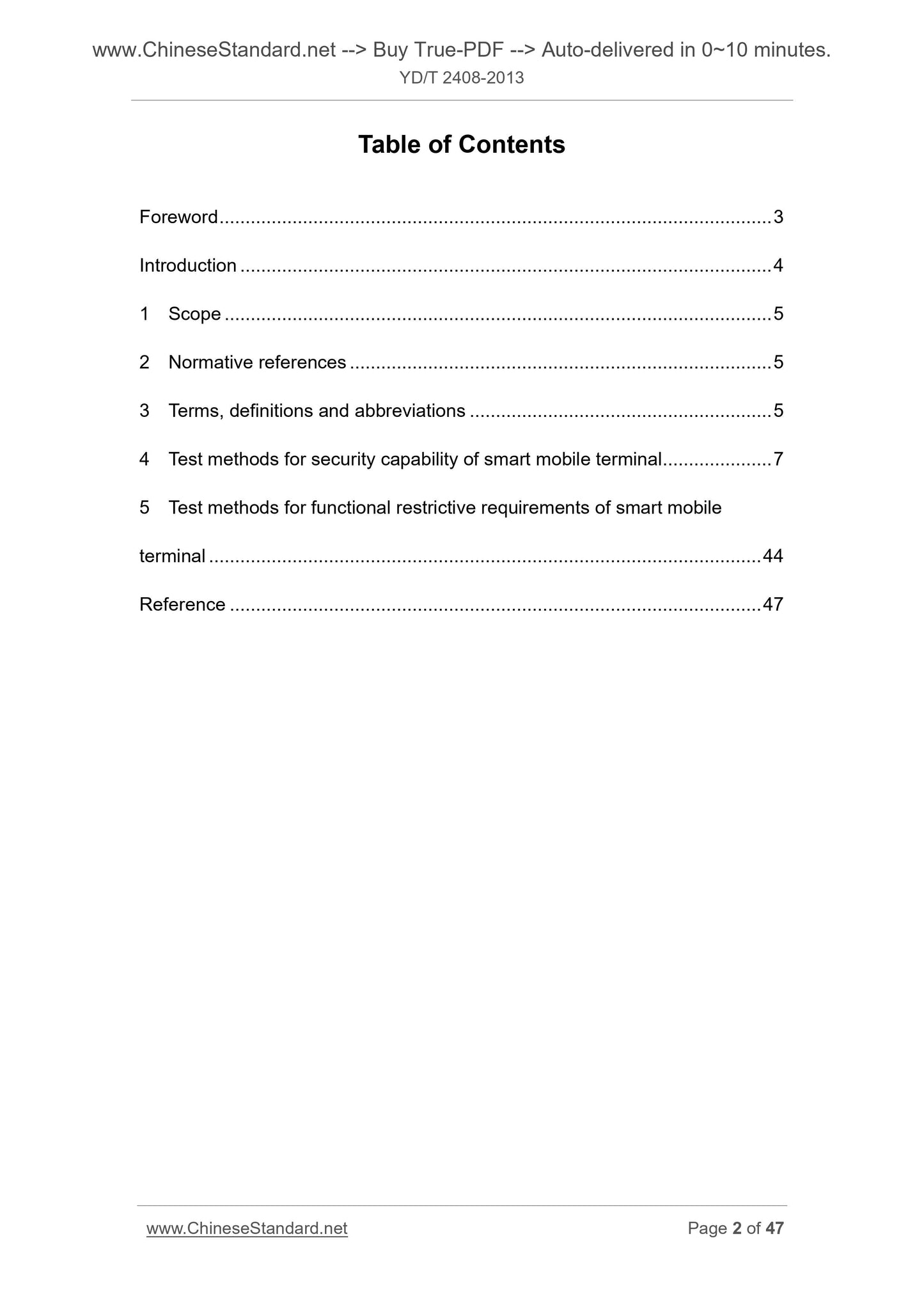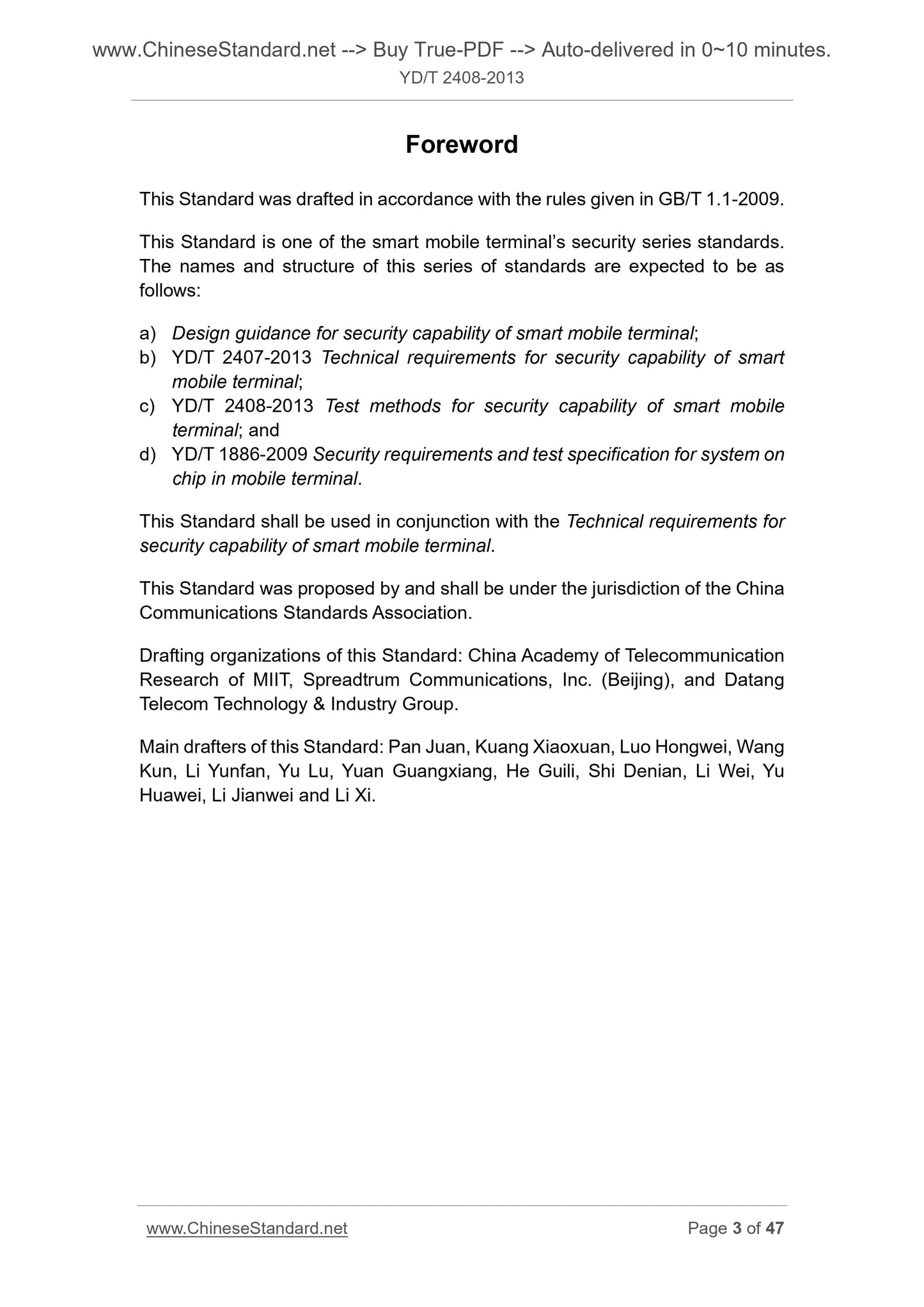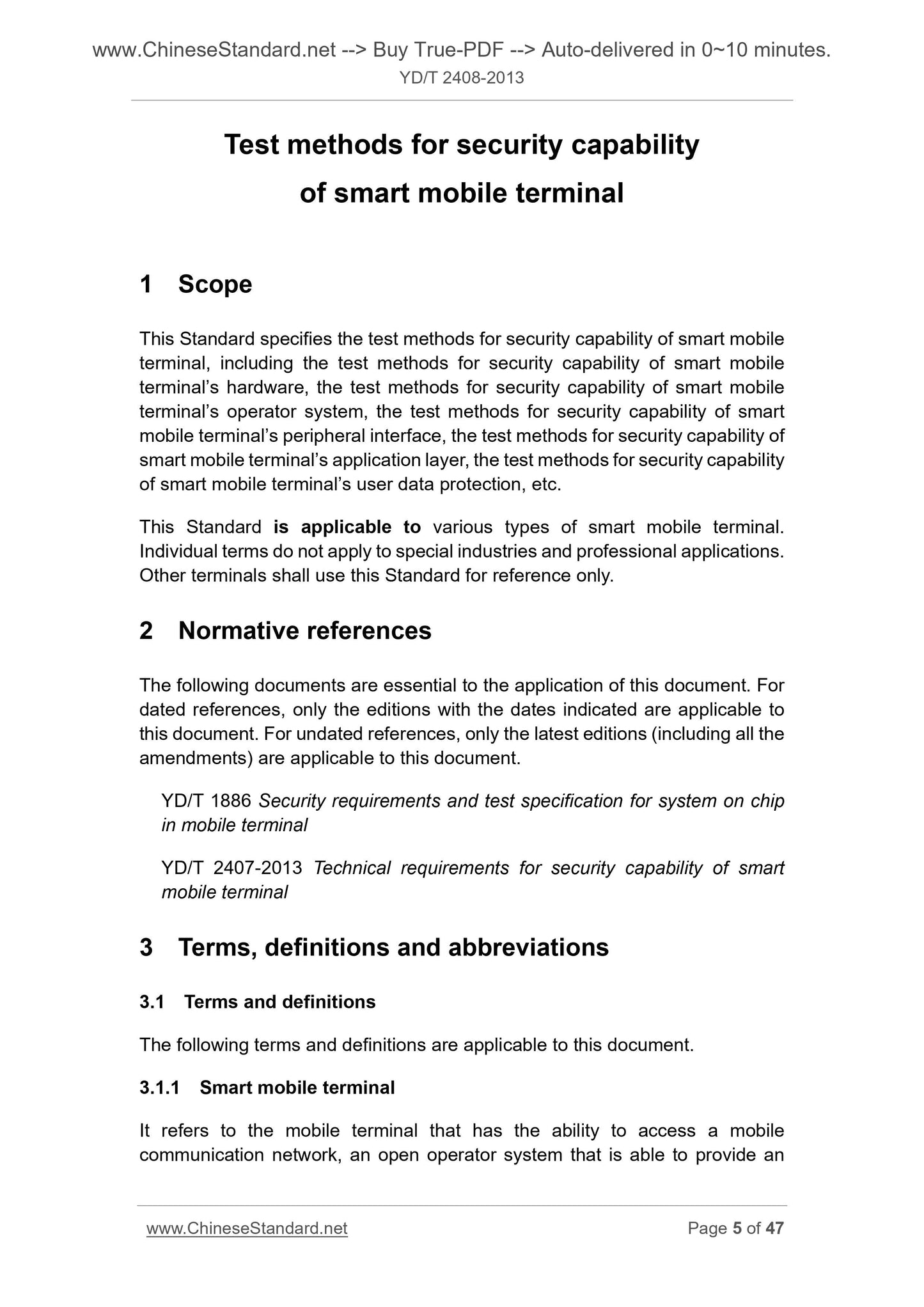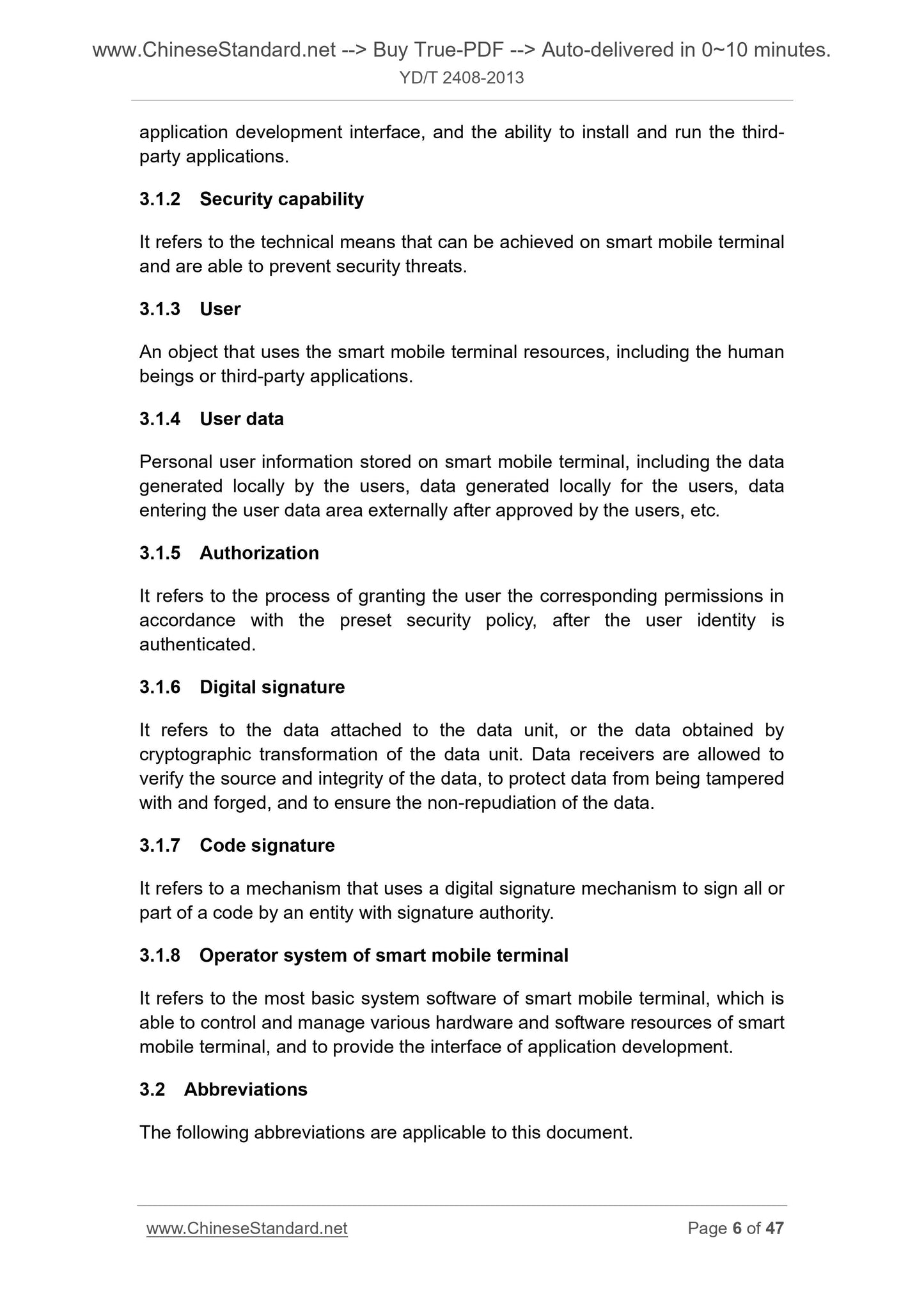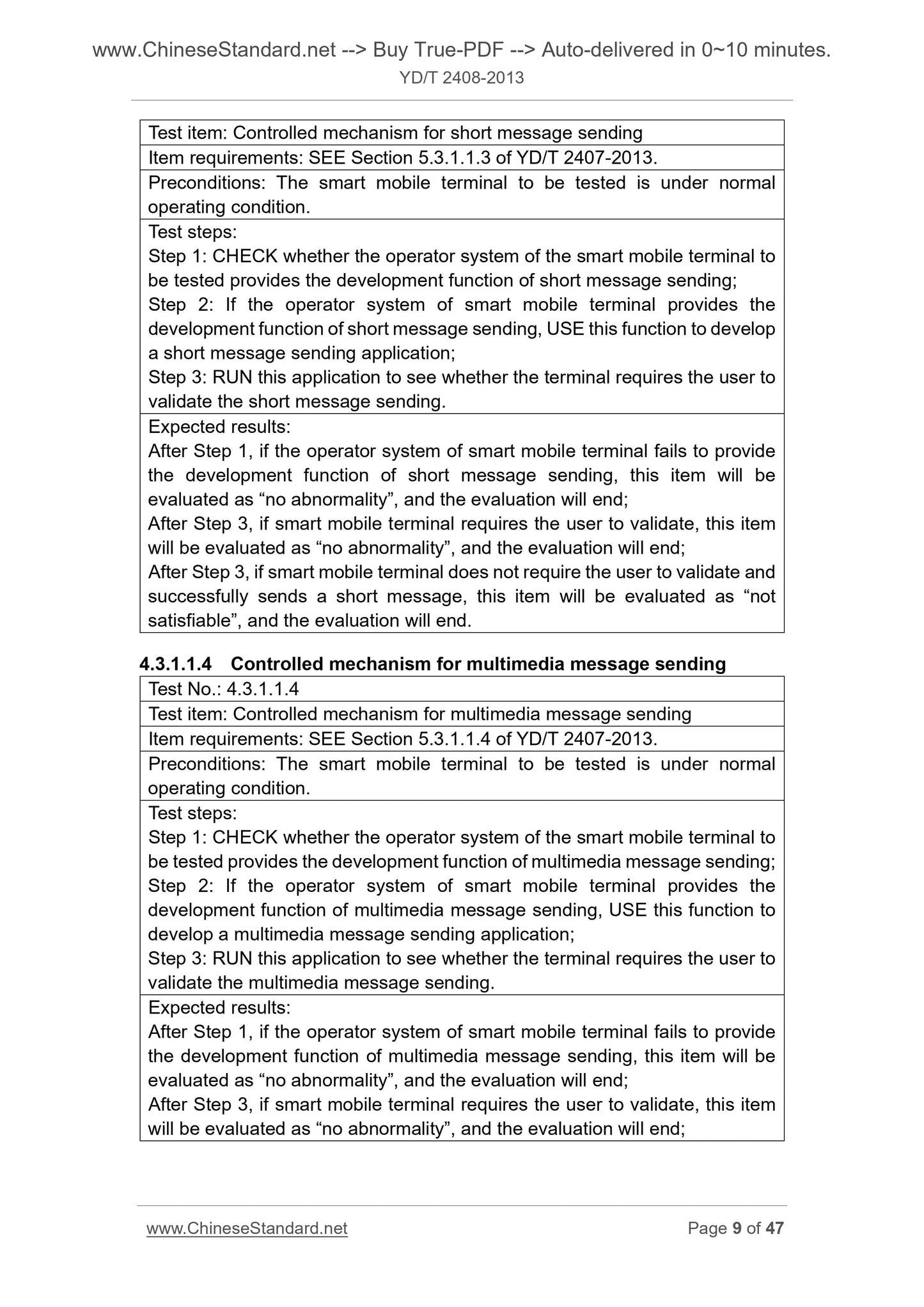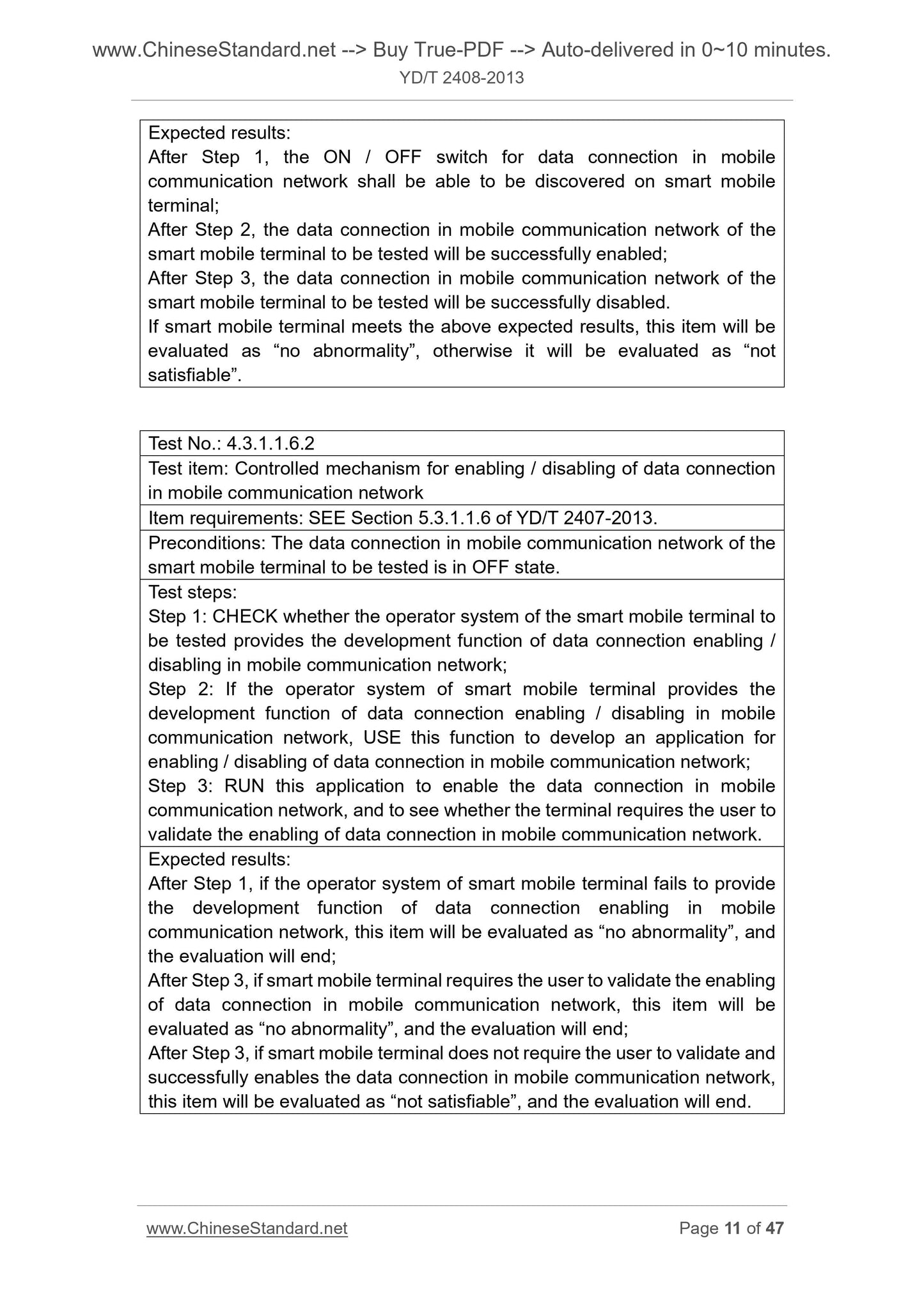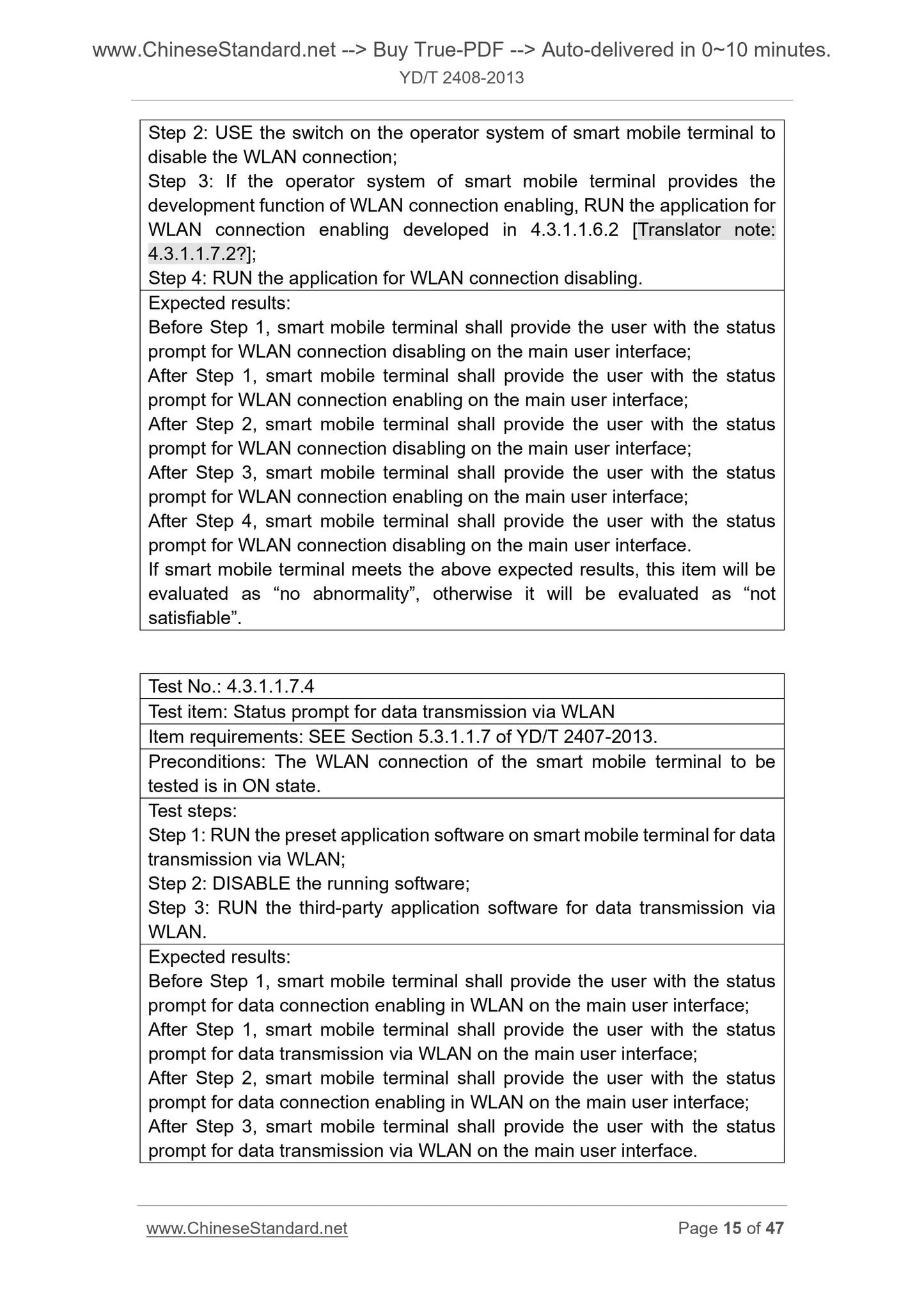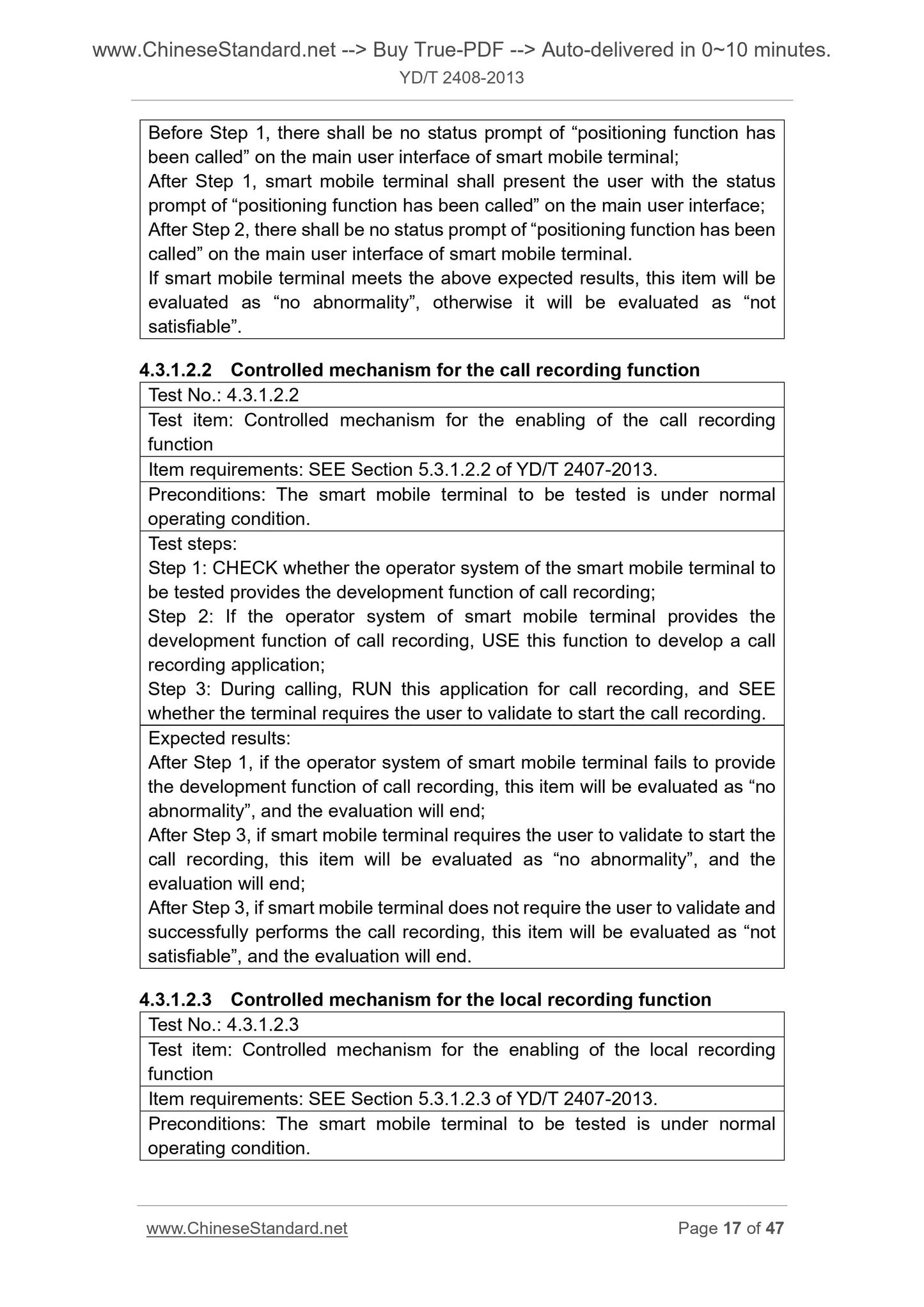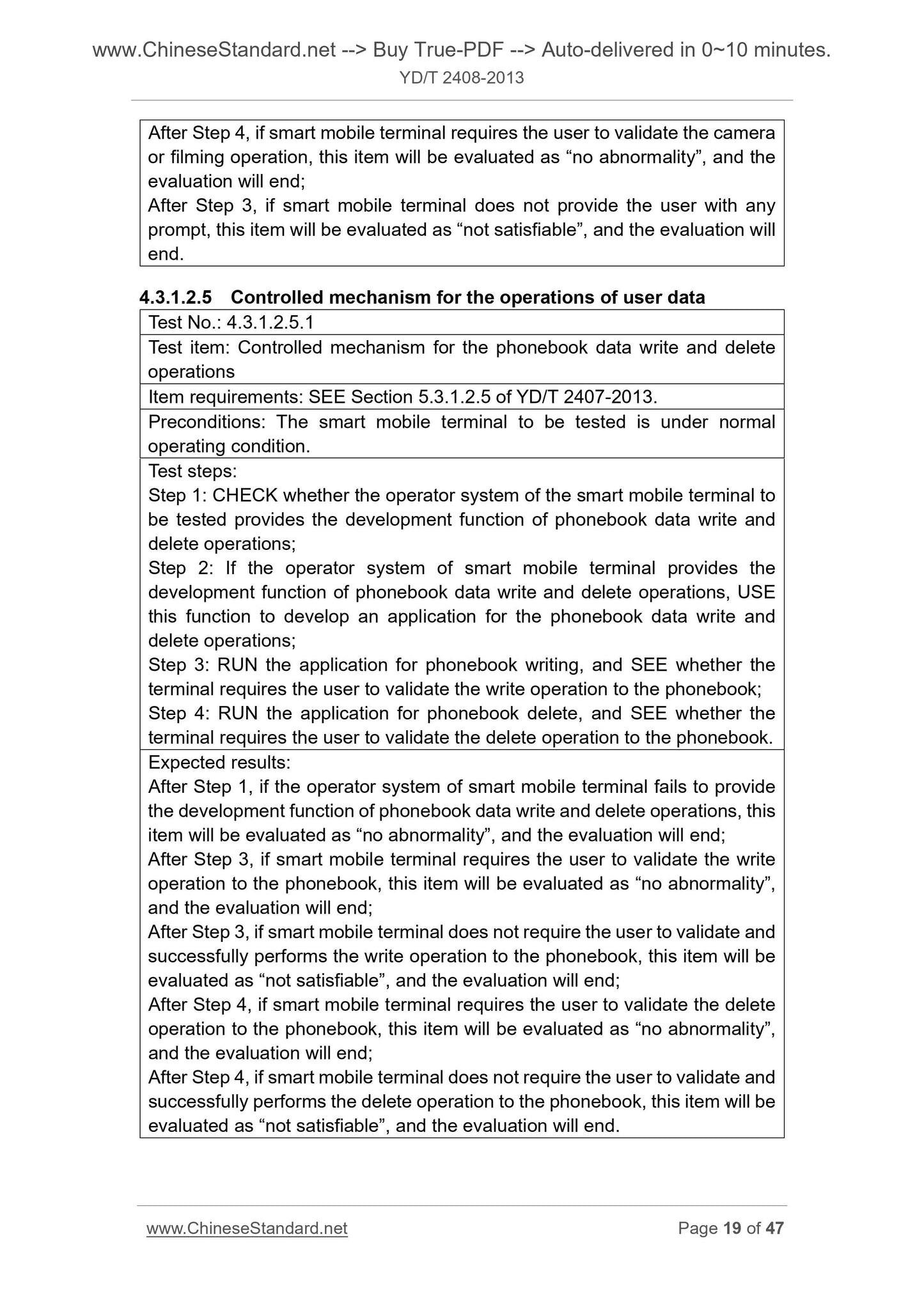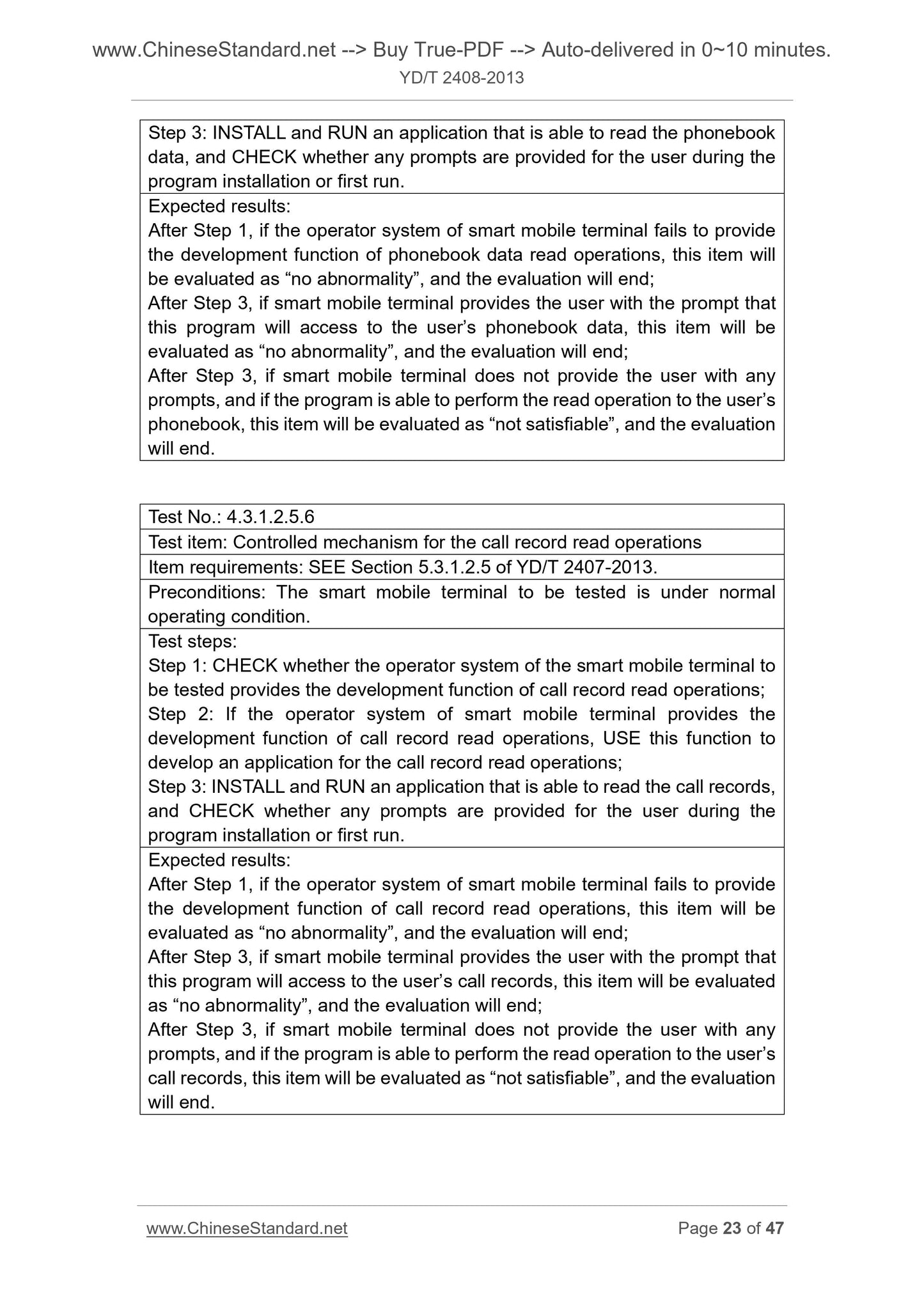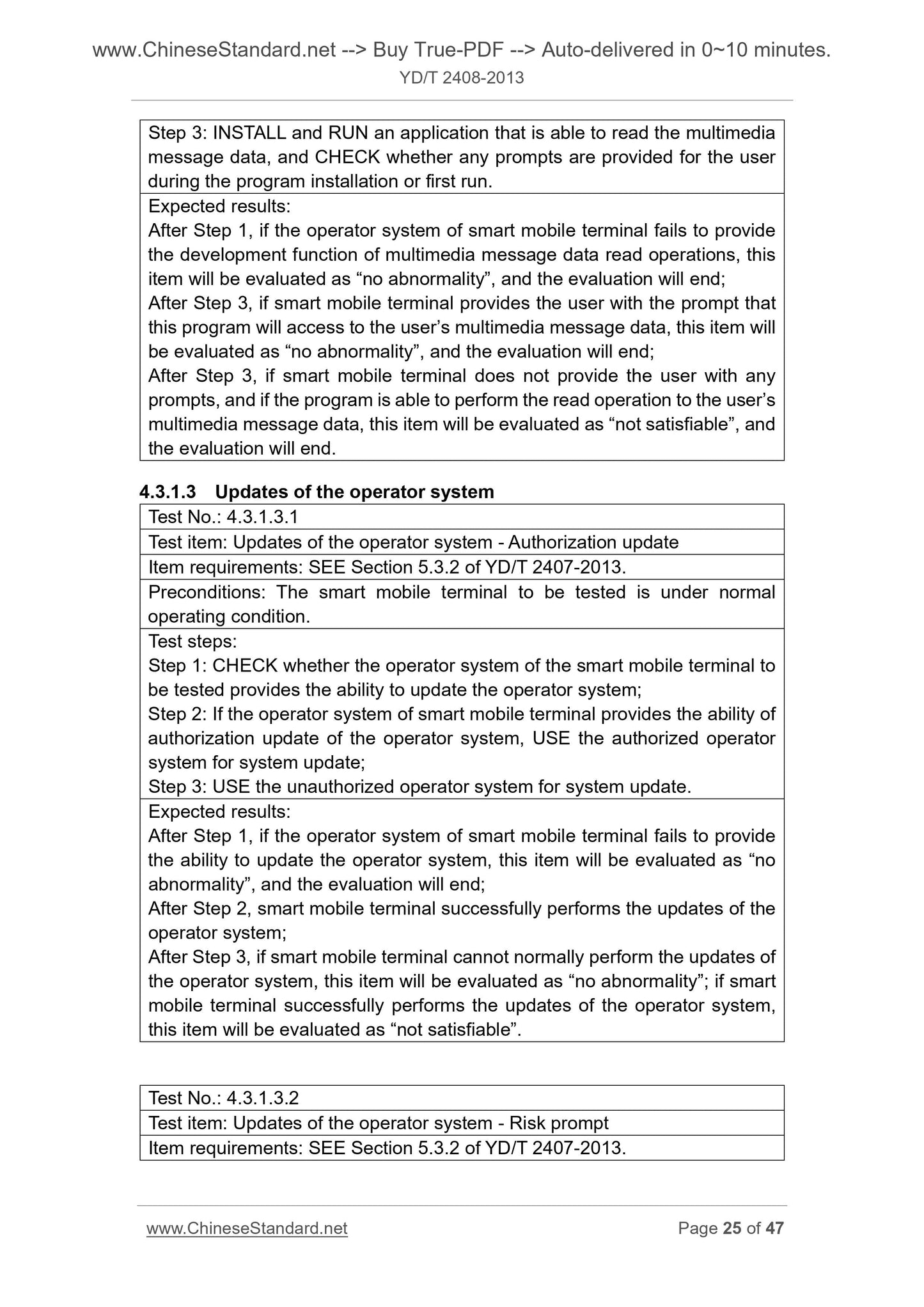1
/
of
12
PayPal, credit cards. Download editable-PDF and invoice in 1 second!
YD/T 2408-2013 English PDF (YD/T2408-2013)
YD/T 2408-2013 English PDF (YD/T2408-2013)
Regular price
$480.00 USD
Regular price
Sale price
$480.00 USD
Unit price
/
per
Shipping calculated at checkout.
Couldn't load pickup availability
Delivery: 3 seconds. Download true-PDF + Invoice.
Get QUOTATION in 1-minute: Click YD/T 2408-2013
Historical versions: YD/T 2408-2013
Preview True-PDF (Reload/Scroll if blank)
YD/T 2408-2013: Test methods for security capability of smart mobile terminal
YD/T 2408-2013
YD
COMMUNICATIONS INDUSTRY STANDARD
OF THE PEOPLE’S REPUBLIC OF CHINA
ICS 33.060
M 36
Test methods for security capability of smart mobile terminal
ISSUED ON. APRIL 25, 2013
IMPLEMENTED ON. NOVEMBER 1, 2013
Issued by. Ministry of Industry and Information Technology of the
People’s Republic of China
Table of Contents
Foreword ... 3
Introduction ... 4
1 Scope ... 5
2 Normative references ... 5
3 Terms, definitions and abbreviations ... 5
4 Test methods for security capability of smart mobile terminal ... 7
5 Test methods for functional restrictive requirements of smart mobile
terminal ... 44
Reference ... 47
Foreword
This Standard was drafted in accordance with the rules given in GB/T 1.1-2009.
This Standard is one of the smart mobile terminal’s security series standards.
The names and structure of this series of standards are expected to be as
follows.
a) Design guidance for security capability of smart mobile terminal;
b) YD/T 2407-2013 Technical requirements for security capability of smart
mobile terminal;
c) YD/T 2408-2013 Test methods for security capability of smart mobile
terminal; and
d) YD/T 1886-2009 Security requirements and test specification for system on
chip in mobile terminal.
This Standard shall be used in conjunction with the Technical requirements for
security capability of smart mobile terminal.
This Standard was proposed by and shall be under the jurisdiction of the China
Communications Standards Association.
Drafting organizations of this Standard. China Academy of Telecommunication
Research of MIIT, Spreadtrum Communications, Inc. (Beijing), and Datang
Telecom Technology and Industry Group.
Main drafters of this Standard. Pan Juan, Kuang Xiaoxuan, Luo Hongwei, Wang
Kun, Li Yunfan, Yu Lu, Yuan Guangxiang, He Guili, Shi Denian, Li Wei, Yu
Huawei, Li Jianwei and Li Xi.
Test methods for security capability
of smart mobile terminal
1 Scope
This Standard specifies the test methods for security capability of smart mobile
terminal, including the test methods for security capability of smart mobile
terminal’s hardware, the test methods for security capability of smart mobile
terminal’s operator system, the test methods for security capability of smart
mobile terminal’s peripheral interface, the test methods for security capability of
smart mobile terminal’s application layer, the test methods for security capability
of smart mobile terminal’s user data protection, etc.
This Standard is applicable to various types of smart mobile terminal.
Individual terms do not apply to special industries and professional applications.
Other terminals shall use this Standard for reference only.
2 Normative references
The following documents are essential to the application of this document. For
dated references, only the editions with the dates indicated are applicable to
this document. For undated references, only the latest editions (including all the
amendments) are applicable to this document.
YD/T 1886 Security requirements and test specification for system on chip
in mobile terminal
YD/T 2407-2013 Technical requirements for security capability of smart
mobile terminal
3 Terms, definitions and abbreviations
3.1 Terms and definitions
The following terms and definitions are applicable to this document.
3.1.1 Smart mobile terminal
It refers to the mobile terminal that has the ability to access a mobile
communication network, an open operator system that is able to provide an
application development interface, and the ability to install and run the third-
party applications.
3.1.2 Security capability
It refers to the technical means that can be achieved on smart mobile terminal
and are able to prevent security threats.
3.1.3 User
An object that uses the smart mobile terminal resources, including the human
beings or third-party applications.
3.1.4 User data
Personal user information stored on smart mobile terminal, including the data
generated locally by the users, data generated locally for the users, data
entering the user data area externally after approved by the users, etc.
3.1.5 Authorization
It refers to the process of granting the user the corresponding permissions in
accordance with the preset security policy, after the user identity is
authenticated.
3.1.6 Digital signature
It refers to the data attached to the data unit, or the data obtained by
cryptographic transformation of the data unit. Data receivers are allowed to
verify the source and integrity of the data, to protect data from being tampered
with and forged, and to ensure the non-repudiation of the data.
3.1.7 Code signature
It refers to a mechanism that uses a digital signature mechanism to sign all or
part of a code by an entity with signature authority.
3.1.8 Operator system of smart mobile terminal
It refers to the most basic system software of smart mobile terminal, which is
able to control and manage various hardware and software resources of smart
mobile terminal, and to provide the interface of application development.
3.2 Abbreviations
The following abbreviations are applicable to this document.
Test item. Controlled mechanism for short message sending
Item requirements. SEE Section 5.3.1.1.3 of YD/T 2407-2013.
Preconditions. The smart mobile terminal to be tested is under normal
operating condition.
Test steps.
Step 1. CHECK whether the operator system of the smart mobile terminal to
be tested provides the development function of short message sending;
Step 2. If the operator system of smart mobile terminal provides the
development function of short message sending, USE this function to develop
a short message sending application;
Step 3. RUN this application to see whether the terminal requires the user to
validate the short message sending.
Expected results.
After Step 1, if the operator system of smart mobile terminal fails to provide
the development function of short message sending, this item will be
evaluated as “no abnormality”, and the evaluation will end;
After Step 3, if smart mobile terminal requires the user to validate, this item
will be evaluated as “no abnormality”, and the evaluation will end;
After Step 3, if smart mobile terminal does not require the user to validate and
successfully sends a short message, this item will be evaluated as “not
satisfiable”, and the evaluation will end.
4.3.1.1.4 Controlled mechanism for multimedia message sending
Test No.. 4.3.1.1.4
Test item. Controlled mechanism for multimedia message sending
Item requirements. SEE Section 5.3.1.1.4 of YD/T 2407-2013.
Preconditions. The smart mobile terminal to be tested is under normal
operating condition.
Test steps.
Step 1. CHECK whether the operator system of the smart mobile terminal to
be tested provides the development function of multimedia message sending;
Step 2. If the operator system of smart mobile terminal provides the
development function of multimedia message sending, USE this function to
develop a multimedia message sending application;
Step 3. RUN this application to see whether the terminal requires the user to
validate the multimedia message sending.
Expected results.
After Step 1, if the operator system of smart mobile terminal fails to provide
the development function of multimedia message sending, this item will be
evaluated as “no abnormality”, and the evaluation...
Get QUOTATION in 1-minute: Click YD/T 2408-2013
Historical versions: YD/T 2408-2013
Preview True-PDF (Reload/Scroll if blank)
YD/T 2408-2013: Test methods for security capability of smart mobile terminal
YD/T 2408-2013
YD
COMMUNICATIONS INDUSTRY STANDARD
OF THE PEOPLE’S REPUBLIC OF CHINA
ICS 33.060
M 36
Test methods for security capability of smart mobile terminal
ISSUED ON. APRIL 25, 2013
IMPLEMENTED ON. NOVEMBER 1, 2013
Issued by. Ministry of Industry and Information Technology of the
People’s Republic of China
Table of Contents
Foreword ... 3
Introduction ... 4
1 Scope ... 5
2 Normative references ... 5
3 Terms, definitions and abbreviations ... 5
4 Test methods for security capability of smart mobile terminal ... 7
5 Test methods for functional restrictive requirements of smart mobile
terminal ... 44
Reference ... 47
Foreword
This Standard was drafted in accordance with the rules given in GB/T 1.1-2009.
This Standard is one of the smart mobile terminal’s security series standards.
The names and structure of this series of standards are expected to be as
follows.
a) Design guidance for security capability of smart mobile terminal;
b) YD/T 2407-2013 Technical requirements for security capability of smart
mobile terminal;
c) YD/T 2408-2013 Test methods for security capability of smart mobile
terminal; and
d) YD/T 1886-2009 Security requirements and test specification for system on
chip in mobile terminal.
This Standard shall be used in conjunction with the Technical requirements for
security capability of smart mobile terminal.
This Standard was proposed by and shall be under the jurisdiction of the China
Communications Standards Association.
Drafting organizations of this Standard. China Academy of Telecommunication
Research of MIIT, Spreadtrum Communications, Inc. (Beijing), and Datang
Telecom Technology and Industry Group.
Main drafters of this Standard. Pan Juan, Kuang Xiaoxuan, Luo Hongwei, Wang
Kun, Li Yunfan, Yu Lu, Yuan Guangxiang, He Guili, Shi Denian, Li Wei, Yu
Huawei, Li Jianwei and Li Xi.
Test methods for security capability
of smart mobile terminal
1 Scope
This Standard specifies the test methods for security capability of smart mobile
terminal, including the test methods for security capability of smart mobile
terminal’s hardware, the test methods for security capability of smart mobile
terminal’s operator system, the test methods for security capability of smart
mobile terminal’s peripheral interface, the test methods for security capability of
smart mobile terminal’s application layer, the test methods for security capability
of smart mobile terminal’s user data protection, etc.
This Standard is applicable to various types of smart mobile terminal.
Individual terms do not apply to special industries and professional applications.
Other terminals shall use this Standard for reference only.
2 Normative references
The following documents are essential to the application of this document. For
dated references, only the editions with the dates indicated are applicable to
this document. For undated references, only the latest editions (including all the
amendments) are applicable to this document.
YD/T 1886 Security requirements and test specification for system on chip
in mobile terminal
YD/T 2407-2013 Technical requirements for security capability of smart
mobile terminal
3 Terms, definitions and abbreviations
3.1 Terms and definitions
The following terms and definitions are applicable to this document.
3.1.1 Smart mobile terminal
It refers to the mobile terminal that has the ability to access a mobile
communication network, an open operator system that is able to provide an
application development interface, and the ability to install and run the third-
party applications.
3.1.2 Security capability
It refers to the technical means that can be achieved on smart mobile terminal
and are able to prevent security threats.
3.1.3 User
An object that uses the smart mobile terminal resources, including the human
beings or third-party applications.
3.1.4 User data
Personal user information stored on smart mobile terminal, including the data
generated locally by the users, data generated locally for the users, data
entering the user data area externally after approved by the users, etc.
3.1.5 Authorization
It refers to the process of granting the user the corresponding permissions in
accordance with the preset security policy, after the user identity is
authenticated.
3.1.6 Digital signature
It refers to the data attached to the data unit, or the data obtained by
cryptographic transformation of the data unit. Data receivers are allowed to
verify the source and integrity of the data, to protect data from being tampered
with and forged, and to ensure the non-repudiation of the data.
3.1.7 Code signature
It refers to a mechanism that uses a digital signature mechanism to sign all or
part of a code by an entity with signature authority.
3.1.8 Operator system of smart mobile terminal
It refers to the most basic system software of smart mobile terminal, which is
able to control and manage various hardware and software resources of smart
mobile terminal, and to provide the interface of application development.
3.2 Abbreviations
The following abbreviations are applicable to this document.
Test item. Controlled mechanism for short message sending
Item requirements. SEE Section 5.3.1.1.3 of YD/T 2407-2013.
Preconditions. The smart mobile terminal to be tested is under normal
operating condition.
Test steps.
Step 1. CHECK whether the operator system of the smart mobile terminal to
be tested provides the development function of short message sending;
Step 2. If the operator system of smart mobile terminal provides the
development function of short message sending, USE this function to develop
a short message sending application;
Step 3. RUN this application to see whether the terminal requires the user to
validate the short message sending.
Expected results.
After Step 1, if the operator system of smart mobile terminal fails to provide
the development function of short message sending, this item will be
evaluated as “no abnormality”, and the evaluation will end;
After Step 3, if smart mobile terminal requires the user to validate, this item
will be evaluated as “no abnormality”, and the evaluation will end;
After Step 3, if smart mobile terminal does not require the user to validate and
successfully sends a short message, this item will be evaluated as “not
satisfiable”, and the evaluation will end.
4.3.1.1.4 Controlled mechanism for multimedia message sending
Test No.. 4.3.1.1.4
Test item. Controlled mechanism for multimedia message sending
Item requirements. SEE Section 5.3.1.1.4 of YD/T 2407-2013.
Preconditions. The smart mobile terminal to be tested is under normal
operating condition.
Test steps.
Step 1. CHECK whether the operator system of the smart mobile terminal to
be tested provides the development function of multimedia message sending;
Step 2. If the operator system of smart mobile terminal provides the
development function of multimedia message sending, USE this function to
develop a multimedia message sending application;
Step 3. RUN this application to see whether the terminal requires the user to
validate the multimedia message sending.
Expected results.
After Step 1, if the operator system of smart mobile terminal fails to provide
the development function of multimedia message sending, this item will be
evaluated as “no abnormality”, and the evaluation...
Share
